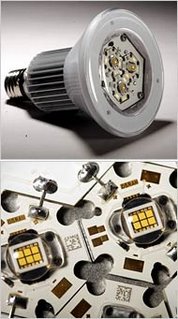 photo: Tony Cenicola/The New York Times
photo: Tony Cenicola/The New York TimesOkay, regarding my earlier post about fluorescent bulbs containing mercury, I've been getting emails asking about an alternative. And yes, there is one (plus, none of that annoying buzzing, which some autistic children are very sensitive to):
From the New York Times:
Q.Are compact fluorescent light bulbs the only energy-saving option?
A. You might try light-emitting diodes, or L.E.D.’s, which give out more light per watt of electricity than compact fluorescent bulbs.
Light-emitting diodes were invented in the ’50s. They are semiconductor devices — a kind of computer chip — that give off light when current is applied to them. Depending on their chemical makeup, they can emit green, blue, red or white light.
L.E.D.’s are now available with standard screw-type bases, so they can easily replace incandescent or compact fluorescent bulbs in your home. They are also sold in “high-hat,” or downlighting, fixtures for the ceiling. The face of most L.E.D. bulbs looks like a circuit board and the light they put out resembles a cluster of brilliant dots, each about the size of an aspirin tablet. An L.E.D.’s light is much whiter than that of a standard incandescent bulb, or even a compact fluorescent bulb, and L.E.D.’s work well on a dimmer or a timer. But like spotlights, they cast their light in one direction, so they don’t work in table lamps.
L.E.D.’s produce about 70 lumens (the standard measure for light) per watt, whereas an incandescent bulb produces only 10 to 15 and the compact fluorescent, only about 35. Unlike compact fluorescent bulbs, L.E.D.’s have no mercury, an important environmental consideration because most bulbs end up in landfills. L.E.D.’s cost more than either conventional or compact fluorescent bulbs, but they last far longer. Whereas the average incandescent bulb costs less than a dollar and a compact fluorescent bulb can sell for a few dollars, some L.E.D.’s run as high as $90 a bulb. But L.E.D. lights are typically rated as having a lifespan of 30,000 to 50,000 hours. So an L.E.D. bulb can last for more than 10 years, if you use it 8 hours a day. Compact fluorescents are typically rated at 7,500 to 10,000 hours, and incandescents at about 1,500 hours. Rather than burning out as incandescent bulbs do, L.E.D.’s light output dims over tens of thousands of hours. L.E.D.’s are also more resistant to vibration than incandescents or screw-in fluorescent bulbs, and do not flicker or hum.
The city of Raleigh, N.C., recently announced that it will begin installing L.E.D.’s in some of its streetlights, and if they work well, will consider converting all 33,000 streetlights to L.E.D., according to Daniel Howe, an assistant city manager. Raleigh is using L.E.D. lights made by Cree Inc., of Durham, N.C., with components developed by the Lighting Sciences Group, of Dallas, which also makes bulbs for home use, shown above.
1 comment:
Thank you for offering a sane alternative to the energy saving mercury lightbulbs. It is hard to believe such a dangerous thing is touted as a green answer.
Thank you, thank you, thank you; i will look into this further.
Post a Comment